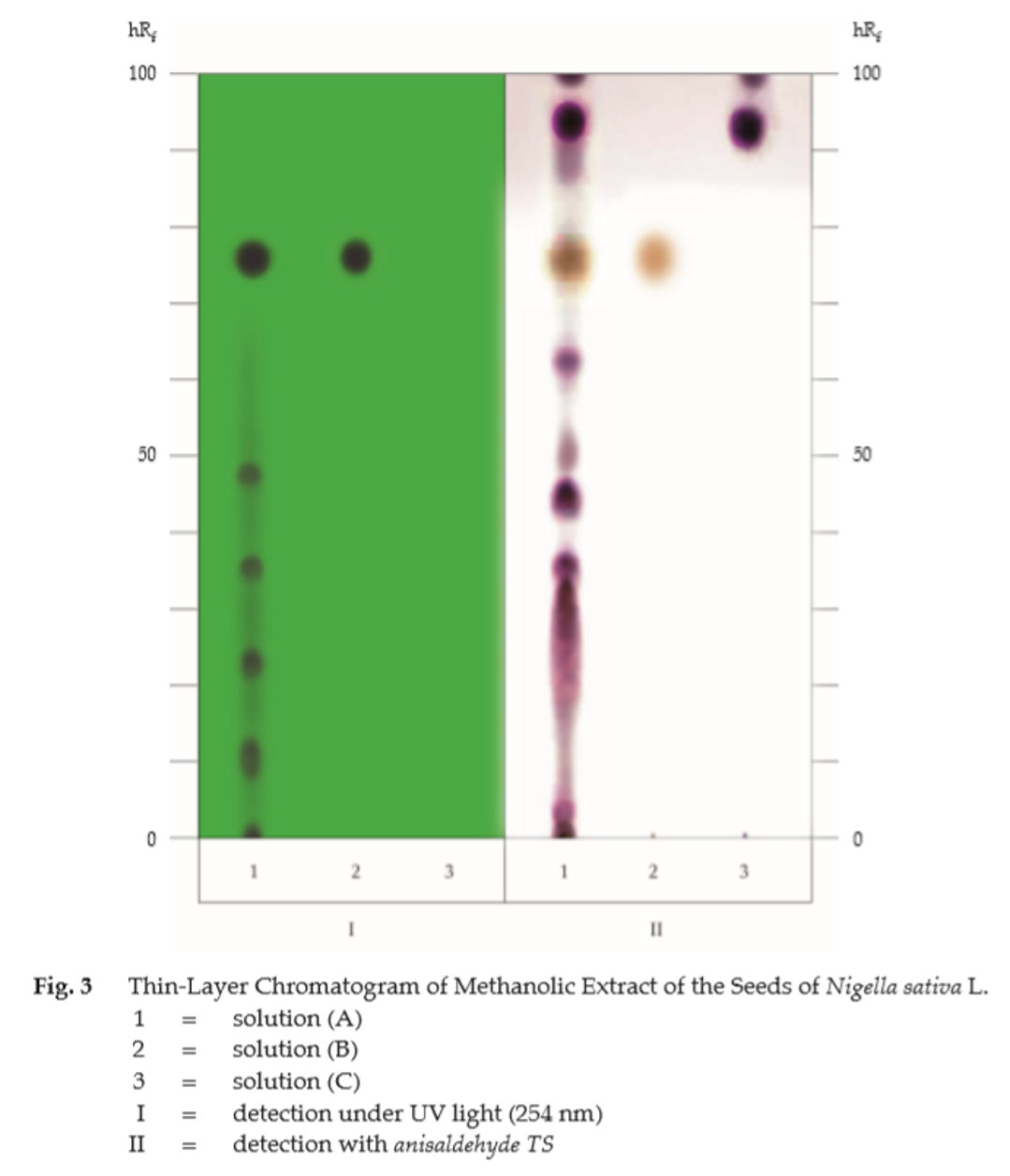ตำรามาตรฐานยาสมุนไพรไทย
Thai Herbal Pharmacopoeia
สำนักยาและวัตถุเสพติด กรมวิทยาศาสตร์การแพทย์ กระทรวงสาธารณสุข
Bureau of Drug and Narcotic, Department of Medical Sciences, Ministry of Public Health(Tinospora crispa (L.) Hook.f. & Thomson)
(Nelumbo nucifera Gaertn.)
(Centella asiatica (L.) Urb.)
(Centella Dry Extract)
(Centella Cream)
(Mesua ferrea L.)
(Piper sarmentosum Roxb.)
(Piper sarmentosum Roxb.)
(Pterocarpus santalinus L. f.)
(Santalum album L.)
(Senna tora (L.) Roxb.)
(Senna alata (L.) Roxb.)
(Senna Alata Tea)
(Piper retrofractum Vahl)
(Myristica fragrans Houtt)
(Andrographis paniculata (Burm. f.) Nees)
(Andrographis Capsules)
(Allium ascalonicum L.)
(Ocimum tenuiflorum L.)
(Curcuma longa L.)
(Turmeric Capsules)
(Turmeric Dry Extract)
(Turmeric Dry Extract Capsules)
(Arcangelisia flava (L.) Merr.)
(Curcuma sp.)
Harrisonia perforata (Blanco) Merr.
(Aristolochia pierrei Lecomte)
(Zingiber officinale Roscoe)
(Ginger Capsules)
(Ginger Tea)
(Cassia fistula L.)
(Nardostachys jatamansi (D. Don) DC.)
(Angelica sinensis (Oliv.) Diels)
Artemisia annua L.
(Ligusticum sinense Oliv. cv. Chuanxiong)
(Neopicrorhiza scrophulariiflora Pennell)
(Atractylodes lancea (Thunb.) DC.)
(Aucklandia lappa Decne)
(Terminalia chebula Retz.)
(Angelica dahurica (Hoffm.) Benth. & Hook. f. ex Franch. & Sav. var. dahurica)
(Kaempferia parviflora Wall. ex Baker)
(Hibiscus sabdariffa L.)
(Roselle Tea)
(Allium sativum L.)
(Zingiber zerumbet (L.) Sm.)
(Wurfbainia testacea (Ridl.) Škorničk.& A. D. Poulsen)
(Cannabis sativa L.)
(Myristica fragrans Houtt)
(Dracaena cochinchinensis (Lour.) S. C. Chen)
(Ficus racemosa L.)
(Hyptis suaveolens (L.) Poit.)
Clerodendrum indicum (L.) Kuntze
(Phyllanthus emblica L.)
(Citrus hystrix DC.)
(Citrus hystrix DC.)
(Areca catechu L.)
(Momordica charantia L.)
Moringa oleifera Lam.
(Aegle marmelos (L.) Corrêa)
(Solanum trilobatum L.)
(Morus alba L.)
Gynostemma pentaphyllum(Thunb.)
Makino
(Clinacanthus nutans (Burm. f.) Lindau)
(Cissus quadrangularis L.)
(Mimusops elengi L.)
(Zingiber montanum (J. König) Link. ex A. Dietr.)
(Piper betle L.)
(Capsicum annuum L.)
(Capsicum Oleoresin)
(Capsicum Gel)
(Piper nigrum L.)
(Piper nigrum L.)
(Eurycoma longifolia Jack)
(Thunbergia laurifolia Lindl.)
(Piper wallichii (Miq.) Hand.-Mazz.)
Senna garrettiana (Craib) H. S. Irwin & Barneby
(Terminalia bellirica (Gaertn.) Roxb.)
(Terminalia chebula Retz.)
(Caesalpinia bonduc (L.) H. Roxb.)
(Tarlmounia elliptica (DC.) H. Rob., S. C. Keeley, Skvaria & R. Chan)
(Hog Creeper Vine Dry Extract Capsiles)
(Hog Creeper Vine Dry Extract)
(Brachypterum scandens (Roxb.) Miq.)
(Lepidium sativum L.)
(Nigella sativa L.)
(Cuminum cyminum L.)
(Foeniculum vulgare Mill.)
(Plantago ovata Forssk.)
(Pimpinella anisum L.)
(Carum carvi L.)
(Anethum graveolens L.)
(Trachyspermum ammi (L.) Sprague)
Albizia procera (Roxb.) Benth.
(Acorus calamus L.)
(Tiliacora triandra (Colebr.) Diels)
Cyanthillium cinereum (L.) H. Rob.
(Orthosiphon aristatus (Blume) Miq.)
Murdannia loriformis (Hassk.) R. S. Rao & Kammathy
(Capparis micracantha DC.)
(Chrysopogon zizanioides (L.) Roberty)
(Cyperus rotundus L.)
(Cannabis sativa L.)
(Syzygium aromaticum (L.) Merr. & L. M. Perry)
(Boesenbergia rotunda (L.) Mansf.)
(Acanthus ebracteatus Vahl)
(Acanthus ilicifolius L.)
(Kaempferia galanga L.)
(Curcuma comosa Roxb.)
Betula alnoides Buch.-Ham. ex D. Don
Cannabis sativa L.
Carthamus tinctorius L
Mitragyna speciosa (Korth.) Havil
Mallotus repandus (Rottler) Müll. Arg
Azadirachta indica A. Juss. var. siamensis Valeton
Azadirachta indica A. Juss. var. siamensis Valeton
Punica granatum L.
Rhinacanthus nasutus (L.) Kurz
Baliospermum solanifolium (Burm.) Suresh
Curcuma aeruginosa Roxb
Boesenbergia kingii Mood & L. M. Prince
Senegalia rugata (Lam.) Britton & Rose
Acacia concinna (Willd.) DC.
Senegalia rugata (Lam.) Britton & Rose
Acacia concinna (Willd.) DC.
Senna alexandriana Mill. var. alexandriana
Cassia acutifolia Delile, Cassia angustifolia Vahl
Butea superba Roxb. ex Willd.
[Plaso superba (Roxb. ex Willd.) Kuntze, Rudolphia superba (Roxb. ex Willd.) Poir.
Pueraria candollei Graham
ex Benth. var. mirifica (Airy Shaw & Suvat.) Niyomdham
Streblus asper Lour.
Suregada multiflora (A. Juss.) Baill. (Gelonium
multiflorum A. Juss.
Black Cumin is the dried ripe seed of Nigella sativa L. (Family Ranunculaceae), Herbarium Specimen Number: DMSC 4536, QSBG 22815, Crude Drug Number: DMSc 418.
Constituents Black Cumin contains volatile oil, of which p-cymene and thymoquinone are its major components. It also contains fixed oil, alkaloids, flavonoids, sterols, etc.
Description of the plant (Fig. 1) Annual herb 30 to 60 cm tall, branched at the top; stem green, round, hairy, 2 to 5 mm in diameter, internodes 2 to 5 cm long. Leaves alternate, 1- to 3-pinnately dissected into linear, linear-lanceolate, capillary or irregularly lobed, lower leaves small, petiolated, upper leaves sessile, 6 to 10 cm long, glabrous on the upper surface, hairy beneath and on the rachis. Flower regular, bisexual, terminal or axillary on branches, white, greenish white or pale blue, about 3 cm in diameter, long-stalked, pedicel 1.5 to 5.5 cm long, becoming longer as the fruit matures. Sepals 5, free, greenish white to pale purple, petaloid, caducous, lanceolate or ovate, 1.2 to 1.5 cm long, 0.4 to 0.5 cm wide, longer than petals. Petals 8, about 5 mm long, about 2.5 mm wide, 3-lobed, anterior lobe small ovate, acuminate, blue, flapped over the fused concave hairy base of the pair of posterior lobes, posterior lobes ovate, greenish white, apex blue with a blue line across the body, each carrying a shining green mass, scantily ciliated. Stamens numerous, outer one longer than the inner ones, basifixed; filament 2.5 to 5.2 mm long, slender; anther 1.5 to 2 mm long; ovary superior, about 5 mm long, smooth, carpels 2 to 4, style and stigma about 7 mm long. Fruit united follicles forming a capsule, ultimately inflated with persistent horn-like styles. Seeds numerous, ovate to lanceolate, trigonal, black.
Description Odourless; taste, bitter, spicy and aromatic.
Macroscopical (Fig. 1) Trigonal to nearly pentagonal, 2.0 to 3.2 mm long, 1.3 to 1.8 mm wide; surface black, rough, glabrous; apex narrow and sharp; base obtuse.
Microscopical (Figs. 2a, 2b) Transverse section of the seed through the cotyledon shows seed coat composed of the three layers; the outer, dark brown, thick-walled cells with irregular papillae; the middle rectangular, brown, thin-walled cells, more or less collapsed; and the inner, dark brown, thick-walled, tangentially rectangular cells. Endosperm, thick-walled polygonal cells containing aleurone grains and oil globules. Cotyledons, thin-walled cells containing aleurone grains and oil globules.
Black Cumin in powder possesses the diagnostic microscopical characters of the unground drug; in surface view, the inner epidermis shows striated wall.
Additional information It is commonly used with other herbal drugs in Thai traditional herbal preparations.
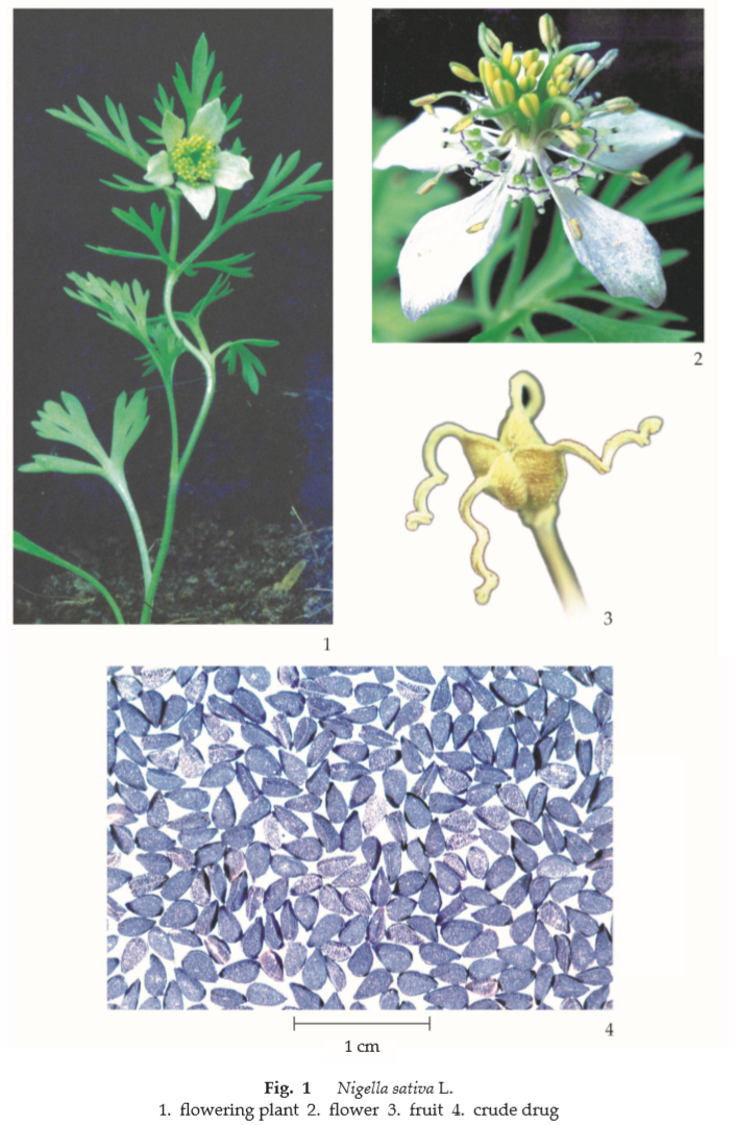
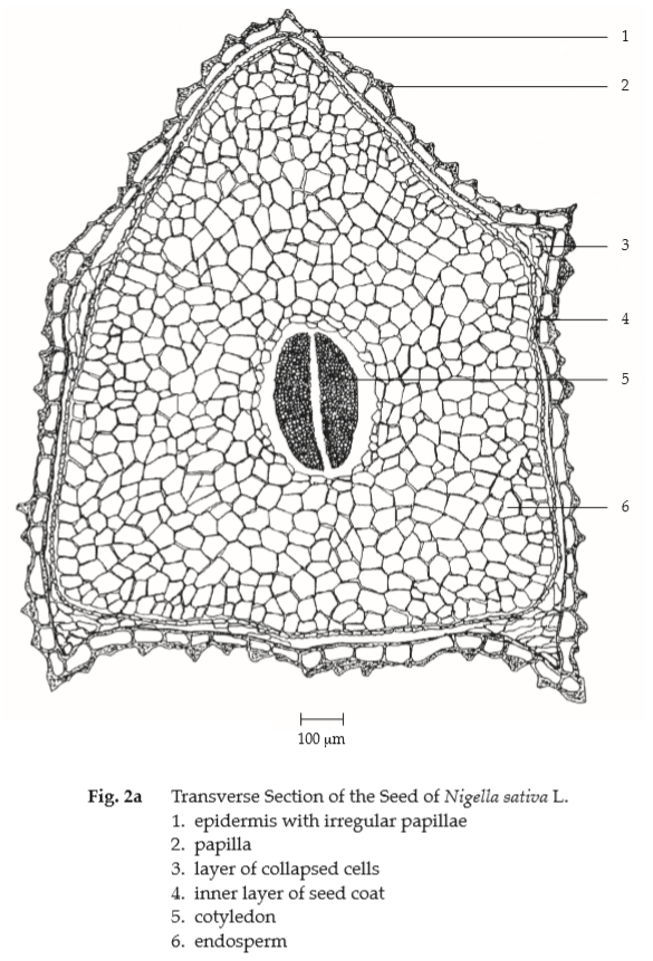
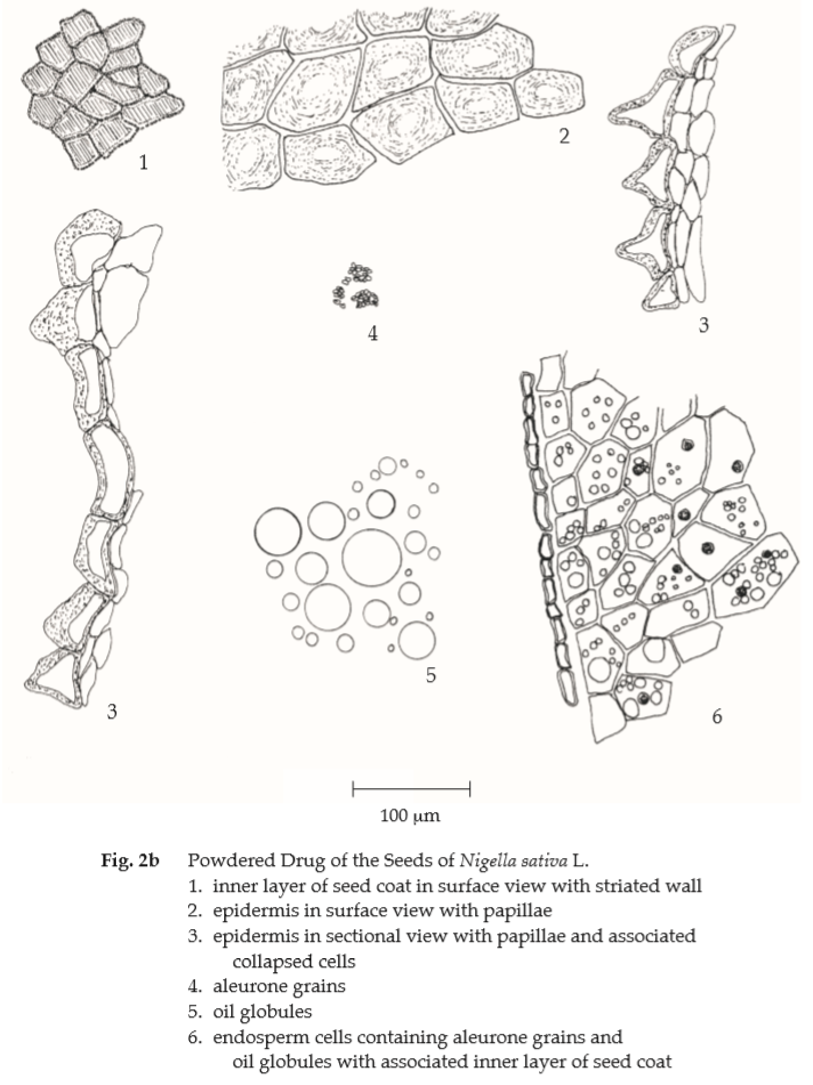
Packaging and storage Black Cumin shall be kept in well-closed containers, preferably of metal or glass, protected from light and stored in a cool and dry place.
Identification
A. Shake 1 g of the sample, in powder, with 20 mL of ethanol for 10 minutes and filter. To 1 mL of the filtrate, add 2 mL of ethanol, 2 drops of ninhydrin TS and place in a water-bath for a few minutes: a violet-blue colour appears.
B. Carry out the test as described in the “Thin-Layer Chromatography” (Appendix 3.1), using silica gel GF254 as the coating substance and a mixture of 90 volumes of toluene and 10 volumes of ethyl acetate as the mobile phase and allowing the solvent front to ascend 12 cm above the line of application. Apply separately to the plate, 2 μL each of solutions (A), (B) and (C). Prepare solution (A) by shaking 3 g of the sample, in powder, with 10 mL of methanol for 2 minutes and filtering. For solution (B), dissolve 2 mg of thymoquinone in 1 mL of methanol. For solution (C), add 10 μL of olive oil to 1 mL of ethyl acetate and mix. After removal of the plate, allow it to dry in air and examine under ultraviolet light (254 nm), marking the quenching spots. The chromatogram obtained from solution (A) shows a quenching spot (hRf value 74 to 76) corresponding to the thymoquinone spot from solution (B), and three spots of lower hRf values. Spray the plate with anisaldehyde TS and heat at 105° for 15 minutes; the spot due to thymoquinone is yellowish brown. One violet spot (hRf value 94 to 96) corresponds to a spot of triglycerides of olive oil from solution (C). Other two pale violet and five violet spots are also observed (Table 1); see also Fig. 3.
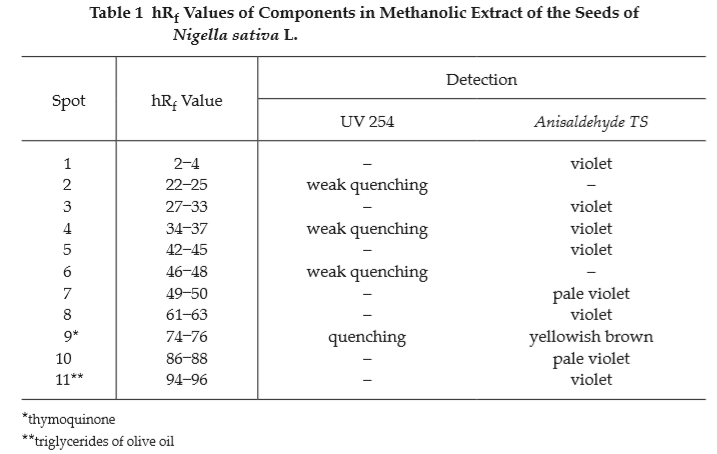
Water Not more than 7.0 per cent v/w (Azeotropic Distillation Method, Appendix 4.12).
Foreign matter Not more than 4.0 per cent w/w (Appendix 7.2).
Total ash Not more than 7.0 per cent w/w (Appendix 7.7).
Ethanol-soluble extractive Not less than 24.0 per cent w/w (Appendix 7.12).
Volatile oil Not less than 0.15 per cent v/w (Appendix 7.3H). Use 20 g, in coarse powder, freshly prepared and accurately weighed. Use 200 mL of water as the distillation liquid and a 500-mL round-bottomed flask. Distil at a rate of 2 to 3 mL per minute for 5 hours. Use 2.0 mL of xylene in the graduated tube.
